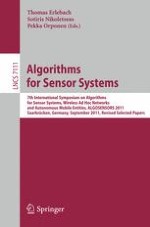2012 | Buch
Algorithms for Sensor Systems
7th International Symposium on Algorithms for Sensor Systems, Wireless Ad Hoc Networks and Autonomous Mobile Entities, ALGOSENSORS 2011, Saarbrücken, Germany, September 8-9, 2011, Revised Selected Papers
herausgegeben von: Thomas Erlebach, Sotiris Nikoletseas, Pekka Orponen
Verlag: Springer Berlin Heidelberg
Buchreihe : Lecture Notes in Computer Science
